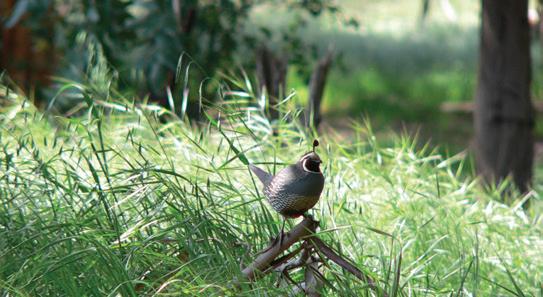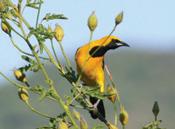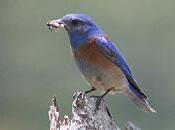OJAI VALLEY
L AND C ONSERVANCY
Protecting your views, trails, water and wildlife

Protecting your views, trails, water and wildlife

When the Ojai Valley Land Conservancy purchased the property that would become the Ojai Meadows Preserve, it was done with the shared community goals of providing relief from localized flooding, reducing storm water pollution, providing a refuge for birds and wildlife, and creating a safe public space where people could enjoy nature close to home. While purchasing the property kept it from ever being developed, the purchase alone did not fulfill the broad community vision. It was known from the beginning that a substantial effort would be required to turn the Preserve into the gem originally envisioned by the community. Shortly after the purchase, a very detailed restoration plan was prepared by a team of professional scientists. The plan continues to guide restoration and long-term management of the Preserve based on strong scientific principles for ecological restoration. The plan included a wetlands development phase, as well as an upland oak woodland development phase. With the wetlands nearing completion, we are now moving into the final upland phase. To date, the work based on this plan has already yielded an additional 100 bird species using the Preserve. We expect this trend to continue as we move from wetlands work to the uplands work.
Looking around the Ojai Meadows Preserve you can see that a lot of activity is underway on the open fields. This work represents the final phase of the master
Continued on next page
Don Reed – President
Sandy Buechley – Vice President
Cricket Twichell – Secretary
Nathan Wallace – Treasurer
Mary Bergen
Bill Brothers
Roger Essick
Margot Griswold
Brian Holly
Staff
Allan Jacobs Ann Oppenheimer
Larry Rose Roger Wachtell Barbara Washburn
Greg Gamble – Executive Director
Brian Stark – Conservation Director
Tania Parker – Director of Advancement
Rick Bisaccia – Preserve Manager
Marti Reid – Office Manager
Lorraine Walter – Watershed Coordinator
Ron Singer – Nursery Manager
Nick Tapia – Restoration Field Crew
Zachary Carter – Restoration Field Crew
Garret Cass – Restoration Field Crew
Dashiell Dunkell – Restoration Field Crew

Continued from previous page restoration plan prepared for the site in 2004. The open fields are currently being managed for weed control and, ultimately, their new function as native grasslands and oak savannas. There are eight management fields within the Preserve and each has a somewhat unique plan. The prescriptions for each field are based on site history, desired habitat type, existing site conditions and vegetation, and soil types and structure. The methods we are employing come from a body of scientific literature on restoration techniques, field experience and adaptation, on-site test plot experience, and a robust monitoring program. The effort will take several years of precise work. The result will be more naturally functional meadows that provide improved habitat for birds and wildlife, reduce annual management costs, and create a pleasing aesthetic. Future visitors will see native bunchgrasses, an assortment of native wildflowers, oak trees and shrubs, and more birds and wildlife.


Continued on next page
The project starts with weed management. Before native seeds can populate the soil and successfully grow, the number of weed seeds in the soil (the seed bank) must be reduced. Options for reducing the seed bank include use of pre-emergent herbicides to kill the seeds, allowing the seeds to grow into plants and using herbicides to kill them, or allowing the seeds to grow and removing the plants manually and/or mechanically. We have chosen the last option in order to avoid the use of herbicides. This option, however, is a bit slower than other options as it requires multiple rounds of mowing and some mechanical soil tilling. For this reason, the fields will be repeatedly cleared of vegetation for the first two full seasons. So far this season, there has not been sufficient rain to grow out the weeds or to germinate any native plants. This same condition can be found throughout the entire Ojai Valley.

At the end of September, the Ojai Valley Land Conservancy’s 10 year easement that allows us to maintain the Ventura River Preserve’s Riverview Trailhead will expire.
Many people probably don’t realize that the Riverview Trailhead on Rice Road does not sit on Ojai Valley Land Conservancy property. This land and about forty acres immediately below the trailhead are owned by the Church of the Living Christ in Meiners Oaks. The Church of the Living Christ has generous ly allowed the Ojai Valley Land Conservancy to maintain this trailhead on its land at no cost for a decade.
On September 30, 2014 the trailhead easement will terminate and this trailhead will close.
The Ojai Valley Land Conservancy would like to be able to re open a trailhead here at some point in the future. The Church of the Living Christ is making preparations to sell this trail head property and the Ojai Valley Land Conservancy hopes to have a chance to buy it, although we will have to compete with other potential buyers.

In anticipation of the closing, Riverview Trailhead regulars should begin to familiarize themselves with the Oso Trailhead to the north and/or the Old Baldwin Trailhead to the south. All parts of the Ventura River Preserve that are accessible by the Riverview Trailhead are also accessible by these other two trailheads.
Continued from previous page
Mechanical work includes mowing and plowing. Three of the fields have been plowed for different reasons, such as to increase water absorption rates to support deeper-rooting native grasses, force a change in dominant weed species from those growing low on the ground to those that can be more accurately managed by mowing, remove rocks that can damage mowers, and make the surface more uniform to increase the efficiency of the mowing. This was a one-time effort to prepare the sites for long-term mowing. Most of the Preserve is simply being mowed just before non-native plants go to seed. This reduces seed production of weeds and gives native seeds a numeric advantage.

seeding advantage. Some plants, such as mustard and wild radish, produce seeds at a higher elevation relative to the native grasses and forbs. Therefore, mowing the fields with the mower set at 10-12 inches above the ground will remove most of the seeding parts of these plants with little impact on the lower-growing natives. This strategy is a numbers game, and usually takes several years to accomplish.
Most of the land has been managed for weed reduction for over a year, and native seeds have now been sown throughout the Preserve. Long term plans are to use timed mowing in the spring to manipulate the seed production of non-native annual plants, giving a seed production advantage to later seeding native plants. This works because the non-native plants, such as mustard, put out seed earlier in the season than the natives. These plants can be mowed
Restoration work at the Ojai Meadows Preserve is being managed by the OVLC’s Conservation Operations Director, Brian Stark. Brian has been planning and implementing habitat restoration projects for almost 20 years, working on 40 different projects within a variety of habitat types. Brian can tell you that there is no one method that fits every project site and every habitat type. Restoration work is often adaptive as changes in the land manifest from project actions, and the path between existing conditions and desired conditions is never a straight line. Managing restoration projects depends on close observation and navigating the most efficient path through a changing landscape.

The eucalyptus grove includes a number of species of eucalyptus trees, none of which are native to North America. The grove has expanded since the original trees were planted, and will continue to spread if not managed. Implicit in the restoration plans for the Preserve is a bias toward native vegetation that provides more appropriate habitats for native birds and wildlife. The restoration plan for the Preserve recommends a phased replacement of eucalyptus trees with oak trees or species associated with the wetland channels over time. The process will take decades to complete marked by periodic efforts of thinning the grove and planting oaks and understory species.
The first eucalyptus trees were removed when the wetland features of the restoration effort were constructed in late 2007. Since that time, our efforts have been focused on restoration of wetland habitats and management of eucalyptus which has consisted only of removing new saplings. Recently, 1/3 of an acre (7.3% of the grove) was thinned of eucalyptus trees to provide more sunlight for new oaks and associated
understory plants, some of which have already been planted. A number of eucalyptus trees still stand in this area and will remain until the oaks gain more stature (see above photo). Activity in eucalyptus management will be periodic with a long-term average of about five trees being replaced each year. However, the replacement is more likely to happen in larger numbers separated by several years to take advantage of the restoration efficiency of a slightly larger scale.
Finally, the OVLC does occasionally remove tree litter from under the
eucalyptus trees as part of our fire protection program. This also has involved periodic trimming of trees so branches cannot transfer a ground fire into the tree canopy. We complete this work as recommended by the Ventura County Fire Department in a partnership for fire safety.
While some of our Preserve visitors enjoy the showy yellow flowers of mustard and the white and purple flowers of wild radish, both of these plants present multiple management challenges for the Preserve. First, these

plants have no natural controls such as insects or herbivores, so they expand unchecked and displace the native plants upon which our native birds and wildlife have come to depend. Surveys of bird utilization on the Ojai Meadows, for example, show that fields dominated by mustard and radish are sparsely used. Our goal in managing mustard and radish is to make room for native plants and draw birds and wildlife back into these fields.
We also manage these species as part of our commitment to maintaining a safe public place. If left unmanaged, these plants become a woody thicket over six feet tall. When they die for the summer, they leave behind a lot of flammable fuel. Preventing the spread of fires through the Preserve is an important goal of our preserve management. Also, when these plants get tall (as shown in the photo to the left, before mustard management), they obscure the views of the Preserve and contribute to security problems. It is easier for people to hide in the tall vegetation, so it is harder to prevent unsafe or illegal activities. The obscured views also reduce opportunities for visitors to see the many bird species utilizing the wetlands on the Preserve. Once native grasses and wildflowers get established on the fields, they will make for a pleasant open landscape that is attractive, safe, less expensive to manage, and more valuable for wildlife.
Generally speaking, we would normally manage weeds by mowing rather than by turning the soil. For three of the eight managed fields, however, we chose to turn the soil to achieve specific goals.
Continued on next page
Annual Preserve Manager Hike and Picnic
April 12, 9 a.m. – 1 p.m.
Learn about the making of the Valley View Preserve trails firsthand from OVLC’s Rick Bisaccia. Ending our hike at a picnic spot with panoramic views of the valley. Space will be limited to 15 people, cost $25 per person.
April 19, 11 a.m. – 4 p.m.
A true family friendly event celebrating Earth Day. Come visit our booth at the Oak Grove School!
Native Plant Sale
April 19, 9 a.m. – 12 p.m.
Nursery Manager Ron Singer will be selling some of the OVLC’s best stock of natives from our own Ojai Meadows Preserve Native Plant Nursery.
Birding Hike
April 26, 8:30 a.m. – 12 p.m.
OVLC docent Peter Larramendy will lead a bird hike on the Wills/Rice Canyon Loop at the Ventura River Preserve.
New Member Mixer (UPDATED)
May 17, 2 – 4 p.m.
* We have changed the date for the new member mixer. Save the new date for a party at the OVLC office. If you recently became a member, watch for your invitation in the mail in May.
May 9, 7 – 8:30 p.m.
Join us for a bird photo presentation by Allan Bertke.
May 10, 8:30 – 10 a.m.
Guided bird walk on the Ojai Meadows Preserve.
June 14, 10 a.m. – 12 p.m.
Ventura County Agricultural History presented by John Krist, CEO Ventura County Farm Bureau.
All Wild About Ojai events are free for members and $10 for nonmembers. Become a member today! A family membership is just $35 per year. Visit www.ovlc.org today, or send in the attached envelope.
To RSVP for an event, contact Marti at (805) 649-6852 or marti@ovlc.org. For an updated list of events, visit www.ovlc.org or “LIKE” us on Facebook.
Continued from previous page
In one example, the field closest to Taormina was disked to allow better water percolation to support deeper-rooted native grasses. The topsoil on this field is actually made up of hardpan clay soil excavated when the main pond was dug. This soil is very dense, has little organic matter, and tends to shed water rather than absorb it. Since water percolation was so shallow, this soil was not likely to support deeper rooted native bunchgrasses. The shallow percolation also created soil conditions that gave an advantage to a shallow rooted weed called filaree. Filaree grows low to the ground and cannot be effectively managed with mowing. It also forms a dense layer of thatch that prevents other seeds from reaching the soil, including the seeds we are sowing for the restoration project.
Disking the soil in this case allowed for better water percolation and removed filaree’s advantage over deeper rooted species. In the short term, this gave an advantage to non-native mustard, a plant with a taproot, which was already present in the seed bank underneath the fill material. In this case, the mustard supplanted the filaree showing that the water percolation strategy was successful at supporting deeper rooted species. The next step is to manage the mustard, but this can be done economically with mowing.
Sometimes restoration of habitats has to start from the ground up and go through several phases before we reach the final results. For short periods, all restoration projects look a little worse before they look better. It can be trying to our patience, but with methodical follow-up, we can reach our restoration goals in a few seasons and enjoy the results for many years after.
Protecting your views, trails, water and wildlife
Thank you to the businesses that support the protection of the Ojai Valley.
Please support OVLC’s business sponsors today.
Ojai Meadows Level
Coldwell Banker Property Shoppe
Old Creek Ranch Winery Patagonia
Sulphur Mountain Level
Barnhart & Barnhart Insurance
Eco Tree Works
Heritage Financial
Meiners Oaks Ace Hardware
Ojai Playhouse
Ojai Rexall Drugs
Oso Ranch
Rogers, Sheffield & Campbell LLP (Phil Moncharsh)
Suzanne’s Cuisine
Waite, Jacobs & Atkinson (Attorneys-at-Law)
bitVision
Dogs Fly Design
Frameworks of Ojai
New Belgium Brewery
Ojai Phone Book
Ojai Valley Directory
Ojai Valley News
Ojai Quarterly
Silver Plumbing
San Antonio Level
Aqua-Flo Supply
Channel Islands Sportfishing
Derby & Derby Inc.
Euterpe Farms
Law Office of Thomas E. Malley
New Oak Ranch
Ojai Café Emporium
Ojai Community Bank Rains
Riverview Ranch
Shanbrom, Casey & Associates
SusanKGuyART.com
The Ojai Valley Inn & Spa
Vintage Production California LLC
Interested in becoming an OVLC business sponsor?
To find out more about business sponsor benefits and how you can help, contact Tania today at (805) 649-6852 ext 6 or tania@ovlc.org
We thank you for your support.
Who doesn’t love the sight of a monarch butterfly in spring? Sadly, that joy is becoming more infrequent as their habitat is being eradicated. A recent L.A. Times article estimated that the yearly migration from Mexico which used to have nearly a billion participants is down to approximately 150 million. One of the main culprits is the rapid disappearance of milkweed, the sole food source for the monarch larvae.
The most common local milkweed, Asclepias fascicularis, is found on our Ojai Meadows Preserve. Narrow-leaf milkweed loves a full day of sun, and almost any kind of soil will do. They emerge in March and multiple stalks grow to two feet tall, covered in hungry (and beneficial) insects, including the monarch larva. It has showy pink/ white blossoms in late summer with amazing silky seedpods afterwards, and is dormant from December through March. If you have a single sunny spot in your garden, you have room for milkweed.
Our plant sale is in April at our Native Plant Nursery on Besant Road. We will have plenty of milkweeds as well as dozens of other drought tolerant native species. Hope to see you then.

April 19, 9 a.m. – 12 p.m.
Nursery Manager Ron Singer will be selling some of the OVLC’s best stock of natives from our own Ojai Meadows Preserve Native Plant Nursery.
Richard & Dashiel Coats
Stan & Debbie Cvijanovich
Daniel Dahlquist
John Drifka
Don Campbell
Megan Emery
Kevin Grigsby
Roy Hooper
Peggy Jones
Bern Kirby
Diane & Lexie Martinez
Bruce Mason
Donna and Ted Miller
Debbie Parisi
Jen Schlaich
Kim & Jed Smith
Margaret Tarmy
Susan Bee in Memory of John G. Bee
Richard & Dashiel Coats in Honor of Rick Bisaccia
PO Box 1092 Ojai, CA 93024 ADDRESS SERVICE REQUESTED
